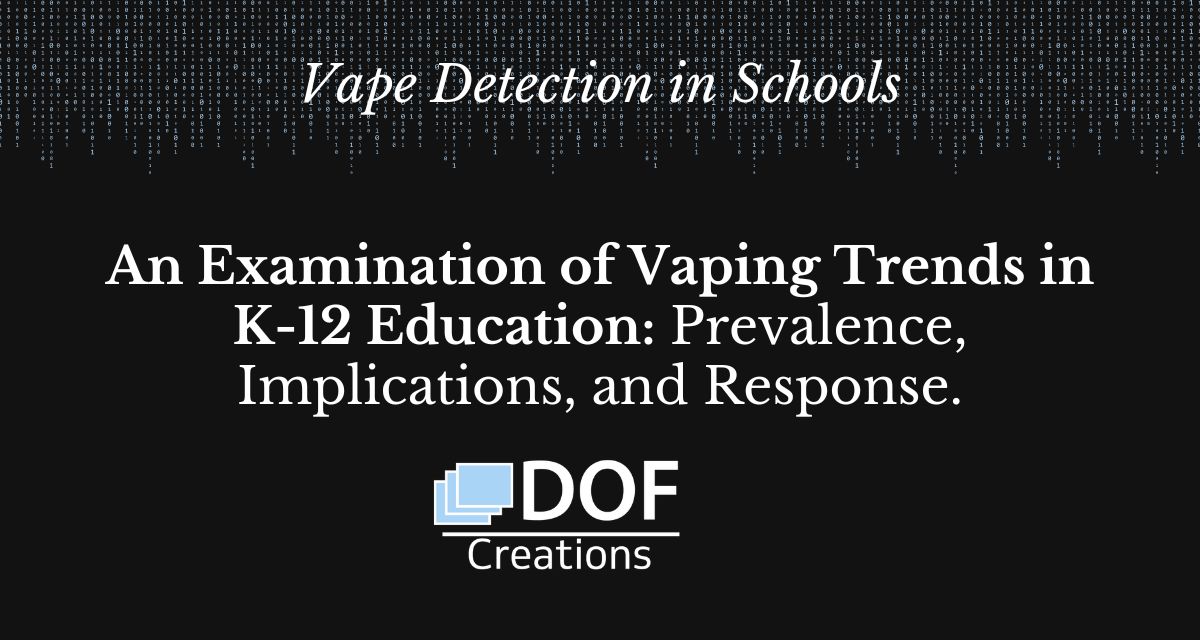Introduction
Since the introduction of e-cigarettes in the mid-2000s, “vaping” has become the biggest addiction across the Country, especially amongst teens. While these devices were initially marketed as a healthier alternative to traditional cigarettes for traditional smokers, they have brought in a wave of new smokers and young adults who were not originally smokers. This new trend poses significant concerns for public health and for American schools that seek to limit the act of vaping on campus and protect their students from this unhealthy activity.
Vaping Prevalence in K-12 Education
According to recent data, the vaping phenomenon has reached epidemic proportions among students in K-12 education. The Centers for Disease Control and Prevention (CDC) report that e-cigarette use among high school students increased from 1.5% in 2011 to 19.6% in 2020. Similarly, the use among middle school students increased from 0.6% in 2011 to 4.7% in 2020.
Vaping trends also appear to be emerging among younger children in elementary schools. Although concrete data is less prevalent for this demographic, anecdotal reports from teachers and parents suggest that e-cigarette usage is starting as early as in fifth grade.
Implications of Vaping in K-12 Education
The rising trend of vaping in K-12 schools has numerous implications, affecting students’ health, academic performance, and social relationships. Firstly, e-cigarettes contain harmful substances such as nicotine, heavy metals, and volatile organic compounds, which have adverse effects on adolescent brain development, lung health, and overall well-being.
Additionally, studies have found that students who vape show decreased academic performance compared to their non-vaping peers. This decrease is hypothesized to be due to the addictive nature of nicotine, causing concentration difficulties and withdrawal symptoms that interfere with learning.
From a social perspective, vaping can create divisions among students, leading to peer pressure and social exclusion. The marketing of e-cigarettes has made them seem ‘cool’ or fashionable to many adolescents, which increases their appeal and contributes to their widespread usage.
Additionally, the ability to use THC in vapes makes it easier to conceal and consume marijuana (weed). This is a particularly concerning event as schools work diligently to maintain the academic environment and curb the consumption of harmful substances on their campuses. Along with this, schools struggle to catch students vaping because they are easy to hide (they can look like innocuous devices) and students can vape in private spaces (ie bathrooms) where cameras are impermissible.
Technology in the Fight Against Vaping in K-12
As the national use of vapes continues to rise, schools have responded in a variety of ways. Many have implemented educational programs to raise awareness about the dangers of vaping, seeking to dispel the myths that e-cigarettes are safe or non-addictive. There is also an increased focus on mental health services in schools, acknowledging the emotional and psychological factors that may lead to substance use. Counselors and health educators work with students to develop healthier coping mechanisms and resist peer pressure.
Furthermore, schools are adopting stricter policies and punishments against vaping on school grounds, with some districts even implementing advanced vapor detectors in bathrooms and locker rooms. Yet, enforcement of vape designs remains a challenge because of their discreet design.
As always, technology is also responding to the issue of detection and prevention. As vape use in schools and other restricted spaces has increased, many resources have popped up on the market to address the issue. Number one on the list is the vape sensor.
Coming in many styles, the vape sensor allows schools to use a non-invasive monitoring solution to identify when and where vaping is occurring. Many of these resources can also tie-in with other surveillance tools to give greater coverage (ie vape alerts that trigger a timestamp in a recording from the nearest camera). This gives schools a way to identify students that are vaping, even in secret, and then get them the help that’s needed.
(In some cases, vape sensor usage has been connected to an over 60% decrease in vaping on campuses)
The Role of Parents and Policymakers
Parents and policymakers also play a crucial role in addressing the vaping epidemic in K-12 schools. Parents should be aware of the signs of vaping and engage in open discussions with their children about its risks. They can also advocate for better school policies and comprehensive health education that covers substance use.
On a broader level, policymakers can restrict the marketing and sale of e-cigarettes to minors and support further research into their health effects. Some states have already enacted laws raising the legal age to purchase these products to 21, following the model of traditional tobacco products.
DOF’s Thoughts
The trend of vaping in K-12 schools is a complex and multifaceted issue that requires a comprehensive and coordinated response. Through education, policy changes, and supportive services such as installing vape detection technology, it’s possible to counteract this trend and protect the health and well-being of our students. However, these efforts must also acknowledge and address the broader social and cultural factors that contribute to youth vaping, aiming for a future where students are not just informed of the dangers of substance use, but also equipped to make healthy decisions in their own right.
For more information on vape sensors, how you can combine them with other monitoring solutions for greater coverage, or grants to purchase them, connect with DOF today at [email protected]



